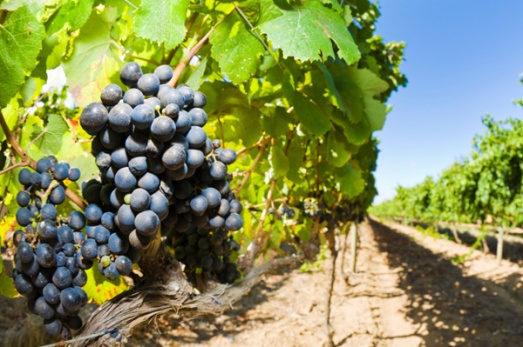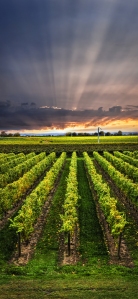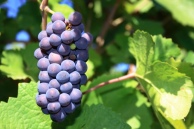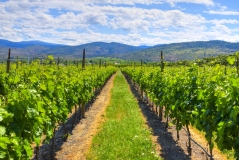 Canada’s wine-making history is relatively short. Beginning in the early 1800s, some of the early European settlers experimented with planting vinifera species from their home country, but these often succumbed to vine diseases in the heat and humidity of summers, and froze to death in the frigid winters. However, indigenous grapes could withstand these conditions. European varietals were still being tested, but labrusca and riparia grapes and their hybrids such as Vidal Blanc, Seyval Blanc, Baco Noir, Concord, Niagara, Duchess and Maréchal Foch made up the majority of the wines. Suffice to say, these were not the stuff of global acclaim.
Canada’s wine-making history is relatively short. Beginning in the early 1800s, some of the early European settlers experimented with planting vinifera species from their home country, but these often succumbed to vine diseases in the heat and humidity of summers, and froze to death in the frigid winters. However, indigenous grapes could withstand these conditions. European varietals were still being tested, but labrusca and riparia grapes and their hybrids such as Vidal Blanc, Seyval Blanc, Baco Noir, Concord, Niagara, Duchess and Maréchal Foch made up the majority of the wines. Suffice to say, these were not the stuff of global acclaim.
In the early 1900s, Canada saw a sweeping temperance movement that enacted a Prohibition in most of the provinces from 1901 in Prince Edward Island, ending for most of the country in 1930 (Prince Edward Island finally relented in 1948). This had similar consequences and black-market equivocations as the American one.
It wasn’t until after the World Wars and the consumer shift from preferring sweet wines to drier styles that the Canadian wine industry stepped things up. In the 1960s, better technology in wine-growing and production allowed local wine-makers to work with better quality, cool-climate vinifera grapes. Riesling, Chardonnay, Chenin Blanc, Gewürztraminer, Pinot Blanc, Pinot Gris, Sauvignon Blanc and Viognier could be planted and maintained for whites. Reds consist of Cabernet Franc, Cabernet Sauvignon, Pinot Noir, Gamay Noir, Merlot and Syrah.
 Through the latter part of the 20th century into the 21st, Canadian wines saw vast improvements in production and quality. Wine societies were formed in the provinces to support and promote the local wine industries.
Through the latter part of the 20th century into the 21st, Canadian wines saw vast improvements in production and quality. Wine societies were formed in the provinces to support and promote the local wine industries.
Ontario Rieslings were the first to garner attention for their excellence. These are produced in every style from dry to sweet, including Botrytis (“noble rot”) dessert wines and Icewines from frozen late harvest grapes. The Vidal grape is also suited to late harvest wines and Icewine styles and has become a notable regional specialty.
Cabernet Franc has become the starring red grape throughout most of Canada, finding its own expressions in different regions. While it is only used as a blending grape in Bordeaux, as in the Loire, Cabernet Franc is capable of high quality solo work as a single varietal release. These range from medium-bodied fruity and herbal versions to styles with denser cassis and chocolate characteristics through extended oak ageing.
Gamay Noir is the specialty of Ontario. These range from young, fruity wines in the carbonic maceration style of Beaujolais Nouveaux to those with more extensive ageing and richer flavors. Bordeaux varietals and blends are also popular in Ontario and British Columbia.
From The Sutton Place Hotel Vancouver, there are a handful of wineries, such as LuLu Island, located within a half hour’s drive south near Richmond and New Westminster. These boutique operations often source grapes from the Okanagan Valley and other growing regions, crushing and making whites, reds, and Icewines on site at the winery. Vancouver Island is home to more than two dozen vineyards, too. Popular grapes include pinot noir, Ortega, gewürztraminer, and several colder-climate grapes. Most Vancouver Island wineries are located on the Saanich Peninsula or in the Cowichan Valley. A unique way to embark on a wine-tasting experience across the Strait of Georgia is by taking a floatplane to Victoria.
These boutique operations often source grapes from the Okanagan Valley and other growing regions, crushing and making whites, reds, and Icewines on site at the winery. Vancouver Island is home to more than two dozen vineyards, too. Popular grapes include pinot noir, Ortega, gewürztraminer, and several colder-climate grapes. Most Vancouver Island wineries are located on the Saanich Peninsula or in the Cowichan Valley. A unique way to embark on a wine-tasting experience across the Strait of Georgia is by taking a floatplane to Victoria.
 Boasting nearly 82 per cent of the total vineyard acreage in British Columbia, the Okanagan Valley is BC’s premier grape growing region. An ever-changing panorama, the valley stretches over 250 kilometres, across distinct sub-regions, each with different soil and climate conditions suited to a growing range of varietals. With more than 150 B.C wineries located in the Okanagan Valley, The Sutton Place Hotel Revelstoke Mountain Resort is an easy hour and a half drive to the vineyard. The valley itself is known for its picturesque wineries overlooking Okanagan Lake and for producing some of the best Icewines in the world plus a variety of other wines covering everything from sparkling to red, white, and dessert. From world-class operations to family-run boutique vineyards, Okanagan wineries are rich with character and consistently ranked among the world’s best at International competitions.
Boasting nearly 82 per cent of the total vineyard acreage in British Columbia, the Okanagan Valley is BC’s premier grape growing region. An ever-changing panorama, the valley stretches over 250 kilometres, across distinct sub-regions, each with different soil and climate conditions suited to a growing range of varietals. With more than 150 B.C wineries located in the Okanagan Valley, The Sutton Place Hotel Revelstoke Mountain Resort is an easy hour and a half drive to the vineyard. The valley itself is known for its picturesque wineries overlooking Okanagan Lake and for producing some of the best Icewines in the world plus a variety of other wines covering everything from sparkling to red, white, and dessert. From world-class operations to family-run boutique vineyards, Okanagan wineries are rich with character and consistently ranked among the world’s best at International competitions.
